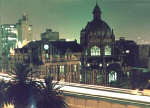
Considered by many to be the most dangerous city in the world, Medellin, Colombia is internationally renowned as the home of Colombian icons, such as drug lord Pablo Escobar and soccer player Andres Escobar.
After Pablo Escobar’s capture in 1982, an entire prison was built specifically for the man whom The Tech called "the billionaire godfather of international cocaine trafficking." This prison, however, actually has more similarities to a three- or four-star hotel than to a jail. In July 1992, Escobar escaped, and was killed in a dramatic rooftop shooting. However, some believe he is alive today, investing some of his riches in expert disguises, fake passports and identification.
Medellin is also where Andres Escobar was shot dead outside a bar, shortly after returning to Colombia from the 1994 World Cup, where he accidentally scored a goal on his own net. "The Colombian defender was gunned down outside a Medellin, Colombia, nightclub on July 2, 1994, days after accidentally scoring an own goal in the World Cup," reported Michael Lewis, who covered soccer for the New York Daily News. "Escobar, who was 27, was shot 12 times as one of the gunmen shouted, ‘Goal! Goal!’"

![]()
However, there’s a lot to Medellin that the international community doesn’t see. Medellin is also the home of Fernando Botero, as well as the annual Flower Festival, a huge event that takes place in the city in late July and early August.
The most famous man in the artistic world from Latin America is from Medellin. Fernando Botero’s work can be seen scattered throughout the city.

A mural decorates a metro station; museums host his earlier paintings, and his transition to sculpture is represented by La Gorda, Adàm, Eva and El Gordo, among others: "His work in three-dimensional art was a natural progression for an artist singularly dedicated to expressing volume and mass." With such subject material and obese style, it is easy to appreciate the progression.
One writer nicknamed Medellin as "una ciudad con cuerpo": a city with body. The personification was explained using some of Botero’s works, which are scattered throughout the city, such as Adám, whose giant back supports the city’s challenged history. The Rio Medellin is alluded to as the spinal cord, which flows steadily though the metropolis. This personification could have been extended to the city’s infrastructure, such as the main metro line, which runs though and over the Antioquian capital guided by the river.

![]()
The Festival de Flores is also a major attraction in Medellin, and takes place at the end of July and early August. This huge annual event is opened with a "caballoero," where about 7,000 campisinos parade through the city on horseback. 
Groups or individuals may have a theme or motto, such as peace, but others prefer to linger along the route, provoking cheers from the large audience. Others gallop, meander or dance their horses of all colours and sizes for the duration of the parade, which goes on for about eight hours.
I admit I was nervous walking though a city with such an infamous past. Although I lived in Colombia for almost three years, I was still cautious about exploring the city. Although things may be slightly better since Pablo Escobar’s death, it’s still not the safest place to be wondering about. It was an exhilarating and rich experience however, and I won’t pass up the chance to go again.